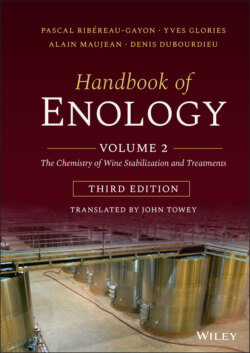Читать книгу Handbook of Enology, Volume 2 - Pascal Ribéreau-Gayon - Страница 55
2.3.2 C4 Polyols: 2,3‐Butanediol and Erythritol
ОглавлениеThe C4 molecule 2,3‐butanediol (Table 2.3) is a diol. It is a by‐product of alcoholic fermentation and is probably also formed by malolactic fermentation. This compound has little odor, and its taste is slightly sweet and bitter at the same time, but it does not have much organoleptic impact in wine. It is stable, and, above all, unaffected by bacteria.
FIGURE 2.5 Mechanism for the formation of acrolein by double dehydration of glycerol.
FIGURE 2.6 Oxidation–reduction equilibria of 2‐3‐butanediol.
The most significant role of 2,3‐butanediol is in maintaining an oxidation–reduction equilibrium with acetoin (or acetyl methyl carbinol) and diacetyl (Figure 2.6). This compound (2,3‐butanediol) is formed following the reduction of acetoin, produced by the condensation of two acetaldehyde molecules.
Acetoin has a slight milky odor and is present at concentrations on the order of 10 mg/l. Diacetyl has a pleasant odor of butter, which may be perceptible at low concentrations (2 mg/l). The diacetyl concentration in wine is generally on the order of 0.3 mg/l.
These two volatile compounds are found in brandy. The concentration in brandy depends on that in the wine, and also on the distillation technique, making it possible to distinguish between Cognac, made by double distillation, and Armagnac, which is distilled only once.
Erythritol (Table 2.3) is also a C4 molecule, but it has four alcohol functions. Small quantities, 30–200 mg/l, are formed by yeast. It is not known to have any special properties.
